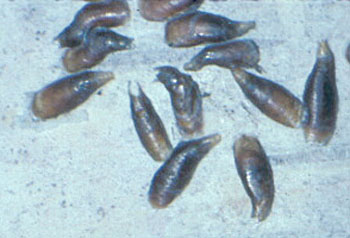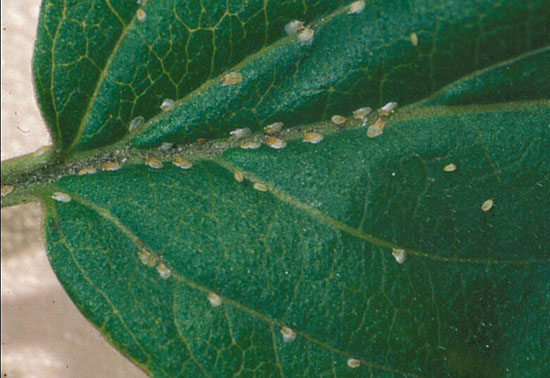Issue 3, May 9, 2011
Oystershell Scale
Oystershell scale feeds on a wide range of trees and shrubs, and is very capable of killing them. It feeds on at least 128 host species found in 19 genera in 12 plant families. This scale is most susceptible to crawler sprays, and crawlers are present and susceptible to control at this time of year.
Oystershell scale is shaped like an oyster's shell, being elongate and wider at one end. Fully grown scales are about one-eighth inch long. There are two races, brown and gray. The brown race, also called the apple race, heavily attacks apple, crabapple, dogwood, and poplar. It produces crawlers earlier than the gray race with crawlers emerging when vanhoutte spirea (bridalwreath spirea) is in full to late bloom, which is likely happening now in southern Illinois. The brown race produces a second generation of crawlers when Queen Anne's lace (wild carrot) is blooming. The gray race, also called the lilac race, heavily attacks lilac, ash, willow, poplar, and maple. Gray race crawlers emerge when vanhoutte spirea has finished bloom. The gray race only has one generation per year in Illinois. Other hosts of one or both races of oystershell scale include boxwood, birch, beech, cotoneaster, elm, horsechestnut, linden, mountain ash, pachysandra, pear, plum, sycamore, tuliptree, viburnum, Virginia creeper, and walnut.

Both races produce gray crawlers that are pinhead-sized and crawl on the stems and leaves. It is relatively easy to spot the crawlers on the leaves, but another scouting method is to wind black electrical tape on infested branches with the sticky side out. Crawlers will get stuck on the adhesive and are easy to see on the black background.
The first stage nymphs or crawlers settle down to feed on stems and gradually lose their legs, eyes, and antennae while they cover themselves with a combination of shed nymphal skins and wax. This waxy covering protects them from most contact insecticides. They feed on cell contents rather than phloem vessels as do soft scales, making them less susceptible to systemic insecticides. The scales mature late in the growing season, overwintering as eggs. As such, they are not very susceptible to dormant oil sprays. The eggs hatch the following spring into crawlers.

All of this makes oystershell scale very susceptible to control only during the crawler stage. There is a window of two to three weeks when contact insecticides such as insecticidal soap, summer spray oil, pyrethroids, and many other insecticides are very effective. As time elapses, they become less susceptible to control.
Oystershell scale commonly attacks only a single branch or side of a tree or shrub, making it important to scout all several areas of the plant. It also allows for significant control by pruning. If early attack is not noticed, the scale is likely to spread to other parts of the tree or shrub, and can kill the entire plant. (Phil Nixon)
Author:
Phil Nixon